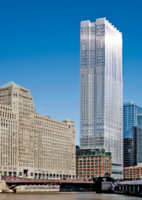Architecture is a cyclical business. Just five years ago, the industry was down in the depths, and now the profession, by most measures, is rebounding.
Signature architecture is central to this trend. High-profile architects add value and reduce risk for developers. Pritzker Prize–winners Christian de Portzamparc, Jean Nouvel, and Herzog & de Meuron have all designed Manhattan condo towers that hover around 1,000 feet tall, while the city's tallest dwelling so far, 432 Park Avenue, by Rafael Viñoly (1,396 feet), will be completed this year. Others even taller are waiting in the wings, by SHoP and Adrian Smith + Gordon Gill. Miami, another hot spot for high-end condos (if not nearly as high as New York's) has seen growing demand from second-home buyers, including many from Latin America, with residential buildings planned or under construction by Zaha Hadid, Rem Koolhaas, Richard Meier, and Bjarke Ingels. And in Chicago, Jeanne Gang recently unveiled a new 1,100-foot-high residential/hotel complex. We are living in a New Gilded Age, and you can read more about it in this issue of RECORD.
In New York, the push for super-slender skyscrapers comes at the time of soaring prices for real estate. These towers are being built on tiny patches of extremely expensive Manhattan property—the 1,428-foot-high SHoP design will sit on a footprint that's just 60 feet wide. Incorporated into the skyscraper's base will be the 1925 landmarked Steinway showroom, designed by Warren & Wetmore. The piano maker agreed to sell its building to SHoP's client, JDS Development Group, for $56 million.
But it's one thing for a company like Steinway to make a tough business decision to let go of such an asset, and quite another for a not-for-profit institution with a long history of serving the public to succumb to similar real-estate pressures. Look at the case of the Museum of Modern Art in New York. MoMA had carefully acquired property around its midtown Manhattan site for decades, enabling several additions to its facilities. But after the expansion by Yoshio Taniguchi opened in 2004, MoMA's board of trustees decided to sell an adjacent vacant parcel. Why sell? According to MoMA director Glenn Lowry, the land had just become too valuable. So the museum sold the property to the Hines company, to develop the supertall 82-story Nouvel condo tower, which has just begun construction. The skyscraper will include three floors for MoMA, adding 36,000 square feet to the museum's exhibition spaces. But after that, the museum will be hemmed in. Forever.
What's more, the museum sold the land, in 2007, for $125 million (and sold its air rights last year for about $14 million). Maybe that looked like a smart move eight years ago, if you were in the real-estate business—as MoMA's board chair is—but was it a good strategy for an institution that plans to be around a century from now? $125 million barely buys a great Picasso these days—and maybe that's what a top apartment in the Nouvel tower could sell for eventually.
Across the street from MoMA, the New York Public Library sold its second-busiest branch, the Donnell Library, to a developer in 2007, too—for $59 million. A hotel and condo complex called Baccarat has just opened on the site, designed by Skidmore, Owings & Merrill (with a small branch library squeezed in, designed by Enrique Norten). The duplex penthouse is listed for—you guessed it—$60 million.
Of course, comparing yesterday's property values to today's in-demand luxury apartments may seem like apples and oranges. And it is. The value to a vibrant nonprofit institution that may want to grow further to fulfill its mission is not the same as the bottom-line values of a commercial enterprise. How much was the potential of that land worth to MoMA's future—$125 million? $500 million? Actually, it was priceless.




